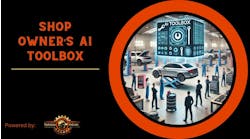Having the appropriate tools, tool storage solutions and shop equipment is critical to helping maintenance shops and technicians save time, produce superior work and boost shop productivity. This, in turn, lessens callbacks and rework, plus decreases vehicle downtime for improved fleet productivity.
The end result: reduced operating costs for shops, fleets and customers.
The key to achieving this is having and using the appropriate tools, tool storage solutions and equipment that are well-designed for the work that needs to be accomplished. Manufacturers design tools/equipment for specific applications and they should be used only for those intended purposes.
When a shop/technician does not have the necessary tools/shop equipment, and the wrong tool/equipment is used instead, vehicle maintenance and repair can be frustrating, as well as inefficient. The wrong tool/equipment is less effective for its intended use.
Moreover, the work can be dangerous for technicians, perhaps causing an injury. The tool/equipment and/or the piece being worked upon could also be damaged.
This increases the risks for accidents. Accidents cause downtime and that impacts job and shop productivity.
HIGH QUALITY
A best practice is to invest in superior quality tools/equipment. This increases their longevity, makes the technician’s job safer and easier and improves the quality of the work being done.
For tools/equipment that are used frequently, always look for ergonomic features.
SAFETY
Even when a shop has the appropriate tools and shop equipment, its technicians need to understand the importance of the choice and use of tools/equipment to do a particular job safely. That includes using the appropriate personal protective equipment (PPE), staying current on safety techniques and following safe operating practices.
Shop managers know that there are occasions when technicians feel that taking the time to get the proper tool to complete a job will slow down their work, or technicians figure that it doesn’t hurt to improvise with a tool/equipment once in a while.
Therefore, it is advisable for shop managers to regularly remind their technicians that improvising with the wrong tool/equipment can result in poor quality work, leading to callbacks/rework. Worse, injuries and property damage can occur when a technician is in a hurry and substitutes what is convenient for the proper tool.
MAINTENANCE
Not to be overlooked is the importance of regularly inspecting, maintaining and servicing tools and shop equipment to keep them in good, safe and reliable working condition. This helps them last as long as possible.
Tools/equipment should be routinely inspected for any defects and/or safety problems and corrected before they become a serious hazard.
A faulty tool should never be used. It needs to be taken out of service until it has been repaired.
Another element to extending the useful life and getting the most return on an investment in tools and shop equipment, as well as tool storage solutions, is habitual cleaning. This also helps to maintain a productive working environment.
STORAGE
Proper organization and storage of tools and shop equipment is also essential to helping them remain in good condition for a long time. Additionally, technician and shop productivity is increased because when tools/equipment are easy to find, available and ready to use when needed, time is not lost looking for them.
Moreover, costs are reduced because tools/equipment are less likely to be lost, damaged or stolen and will not have to be replaced.
A best practice is to have suitable fixtures with marked locations to provide orderly arrangement of tools/equipment. Technicians need to be reminded to return tools/equipment promptly after use, as this reduces the chance of their being misplaced or lost.
Plus, their doing so can help prevent accidents because if the tools/equipment are left or placed in an incorrect area, there is a possibility that someone could slip or trip over them.
IN SUM
To summarize, the best return on investment in tools, tool storage solutions and shop equipment comes from:
- Choosing the appropriate ones.
- Making sure they remain in safe, reliable condition.
- Using them only for their intended purposes.
- Properly maintaining them.
- Storing them safely.
No shop or technician can hope to be successful and prosper without accomplishing these objectives. This Tool & Equipment Special is intended to assist with this.
This Special contains the latest tools, tool storage solutions and shop equipment for automotive repair. There is also insightful information, along with purchasing considerations, intended to help with making the wisest acquisition decisions to meet a shop’s particular needs.
Be sure to share this resource with your technicians.




